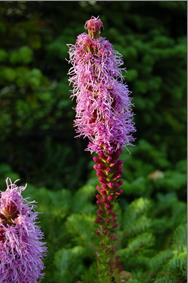Difference between revisions of "Liatris, gay feather"
m (→Special Considerations) |
|||
| (3 intermediate revisions by one other user not shown) | |||
| Line 24: | Line 24: | ||
Liatris are normally packed in horizontal fibreboard boxes, but may also be packed in hampers.<br> | Liatris are normally packed in horizontal fibreboard boxes, but may also be packed in hampers.<br> | ||
====Special Considerations==== | ====Special Considerations==== | ||
| − | Be careful of fungal problems such as Botrytis (especially for those grown outdoors) as well as water stress. Leaf yellowing and reduced life are common when these problems exist and are not easily controlled. Using preservative solution helps open more flowers per stem, but doesn’t make individual flowers last longer. A member of the Asteraceae (chrysanthemum or [[aster]] family), this species is also unusual in that flowers open from the top of the stem downwards; delphinium, gladiolus, snapdragon, and most other spiked-type flowers open from the bottom up. | + | Be careful of fungal problems such as Botrytis (especially for those grown outdoors) as well as water stress. Leaf yellowing and reduced life are common when these problems exist and are not easily controlled. Using preservative solution helps open more flowers per stem, but doesn’t make individual flowers last longer. A member of the Asteraceae (chrysanthemum or [[aster]] family), this species is also unusual in that flowers open from the top of the stem downwards; delphinium, gladiolus, [[snapdragon]], and most other spiked-type flowers open from the bottom up. |
<br><br><br> | <br><br><br> | ||
<b>Sources used</b><br> | <b>Sources used</b><br> | ||
| − | BMT | + | BMT Consolidated Manual on (Dutch) [[Flower Bulbs]], cut flowers/greens and potted [[plants]]. |
| − | + | ||
| + | |||
| + | [[Category: Products]][[Category: Perishables]] | ||
Latest revision as of 12:52, 14 January 2021
| Infobox on Liatris, gay feather | |
|---|---|
| Example of Liatris, gay feather |  |
| Facts | |
| Origin | - |
| Stowage factor (in m3/t) | - |
| Humidity / moisture | - |
| Ventilation | - |
| Risk factors | See text |
Liatris, gay feather
Contents
Description / Shipment / Storage / Risk factors
Scientific Name and Introduction
Liatris pycnostachya, L. spicata. The specific epithet pycnostachya means thick-spiked in reference to flowers while spicata means spike.
L. spicata is the taller of the two species. Native to prairies of North America, liatris was developed as a cut flower in Israel. The bright purple spikes provide interesting texture and line in arrangements, and can open fully if properly treated after harvest.
Quality Characteristics and Criteria
Liatris spikes should be harvested with no more than 25% to 33% of the flowers in the spike open. They may be harvested with only the top buds showing colour and will open fully if provided with an effective preservative. Liatris responds best when about one-quarter to one-third of the flowers are open. However, if preservative solution is properly used, flowers can be harvested with no colour showing and subsequently opened.
Grading and Bunching
Quality Liatris flowers are of proper maturity (no more than one third of the flowers on the spike open), are free from defects and damage, and have good quality foliage. They are normally bunched in groups of ten and sometimes sleeved.
Ethylene Sensitivity
Liatris flowers are not affected by exposure to ethylene.
Pretreatments
Pulsing with preservative containing additional sugar (10 to 20%; about 100 gr of sugar per quart or litre of water) will improve opening of tight-cut flowers.
Storage Conditions
Store Liatris at 0°C to 1ºC.
Packing
Liatris are normally packed in horizontal fibreboard boxes, but may also be packed in hampers.
Special Considerations
Be careful of fungal problems such as Botrytis (especially for those grown outdoors) as well as water stress. Leaf yellowing and reduced life are common when these problems exist and are not easily controlled. Using preservative solution helps open more flowers per stem, but doesn’t make individual flowers last longer. A member of the Asteraceae (chrysanthemum or aster family), this species is also unusual in that flowers open from the top of the stem downwards; delphinium, gladiolus, snapdragon, and most other spiked-type flowers open from the bottom up.
Sources used
BMT Consolidated Manual on (Dutch) Flower Bulbs, cut flowers/greens and potted plants.











